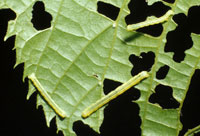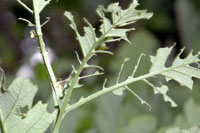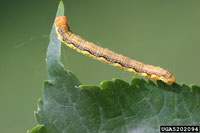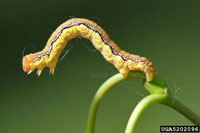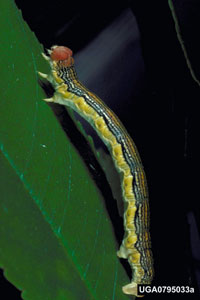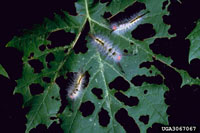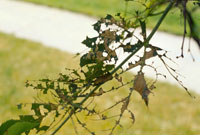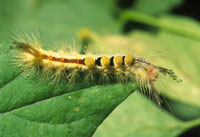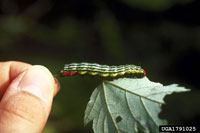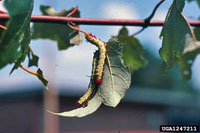Extension > Garden > Diagnose a problem > What's wrong with my plant? > Deciduous Trees > Maple > Holes in leaves or parts of leaves missing
Maple > Leaves > Holes in leaves or parts of leaves missing
1 of 4
Cankerworms
Alsophila pometaria (fall) and Paleacrita vernata (spring)
- Larvae chew between the major veins at first, eventually chewing everything except midveins
- Defoliation typically light to moderate, although it can be severe
- Smooth-bodied, light green to brown, 2 inches long when fully grown; moves in characteristic looping motion
- Damage occurs late April/early May until June
- More information on Cankerworms
2 of 4
Linden looper
Erannis tiliaria
- Chews portions of leaves; defoliation typically is minor
- Smooth-bodied with reddish brown head, it is patterned black, gray, yellow, with a light colored underside; moves in characteristic looping motion; 1 ½ inch long
- Occurs May and June
- More information on Linden looper
3 of 4
Whitemarked tussock moth
Orygia leucostigma
- Young larvae windowpane feed (i.e. feed on one layer of leaf tissue between veins) giving them a lacelike appearance
- Older larvae consume entire leaves except the midrib and large veins
- Caterpillars have a red-orange head with two sets of black tufts near the head; yellowish hairy body with distinct tufts of hair resembling a toothbrush on top of the body
- Full grown larvae are 1 ¼ inches long
- Damage by 2 generations- first from May to June and a second one from August to September
- More information on Whitemarked tussock moth
4 of 4
Greenstriped mapleworm
Dryocampa rubicunda
- Defoliate trees by eating entire leaves, except the central vein
- Mature larvae with red head, 7 lines running longitudinal down body that are light to dark green; 2 “horns” just behind the head
- At maturity, 1.5 inches long
- Feeding common late July and early August
- More information on Greenstriped mapleworm



